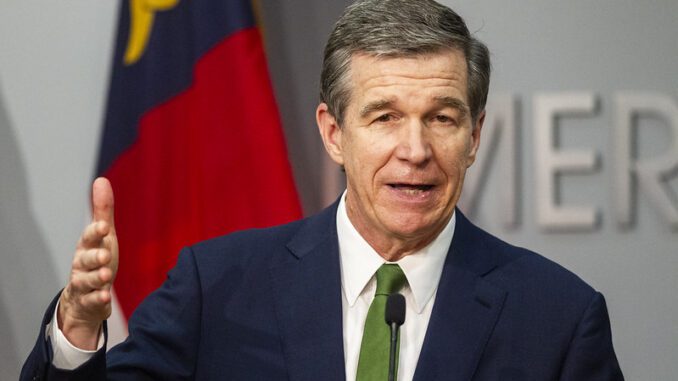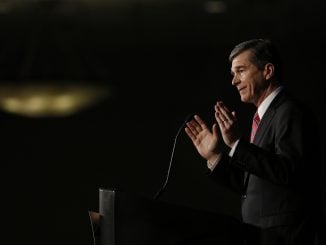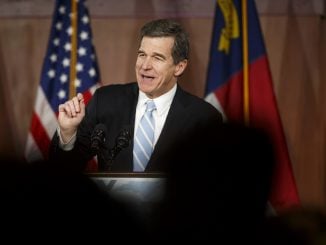
RALEIGH — At the first in-person COVID-19 media briefing in over 400 days, on June 2, Gov. Roy Cooper said North Carolina’s state-of-emergency order needed to continue and would not say when it will be lifted. The governor also made the claim that being able to “draw down” federal funding was contingent on keeping North Carolina under a state of emergency.
But that appears not to be true.
“The state of emergency needs to continue,” said Cooper during the briefing. “We need to continue to draw down federal funds. We need to continue to do things to make sure people get vaccinated and we still have mask mandates in places that are recommended by the CDC.”
North Carolina’s state of emergency for COVID-19 is contained in Executive Order 116, which Cooper issued on March 10, 2020. Unlike the 70 other COVID-19 orders issued by Cooper, the state-of-emergency order has no expiration date.
Order 116 states that, “The State of Emergency maintains state’s ability to receive federal funding to meet challenges presented by COVID-19;” however, this does not appear to be correct.
An examination of the CARES Act and President Biden’s American Rescue Plan (ARP) does not reveal any requirement for a state of emergency to be in place for a state to qualify. One pool of federal funds that may have ties to a state-of-emergency order is FEMA’s Lost Wages Supplemental Payment Assistance. The state application template provided by FEMA includes language about the delivery and administration of funds for the program through a “major disaster” declaration under the Stafford Act. That declaration, however, is made by the president of the United States, not a state governor.
At the briefing, Cooper added there are “many other reasons” to maintain the state of emergency order but did not give many specifics.
“The state of emergency has been able to help us free up resources, personnel, to be able to waive regulations, in order to stem the tide of this virus, to help get people vaccinated,” Cooper said in response to a question from North State Journal.
NSJ reached out to the governor’s office for clarification on what federal funds he was referring to but did not receive a response. Additionally, the regional communication director for the White House directed NSJ’s inquiry to the U.S. Treasury. A response from the Treasury was not received before press time.
State legislative leaders were also contacted by NSJ in an attempt to verify if a state of emergency was required in order to receive pandemic-related relief, such as the CARES Act or the American Rescue Plan.
Senate Leader Phil Berger’s (R-Eden) communications director, Lauren Horsch, issued a statement on Cooper’s continued state of emergency order:
It’s wrong to keep the state in a declared emergency when nearly all restrictions have been determined to be unnecessary. What should citizens of North Carolina believe — the science and data or what the Governor is telling them? Now that COVID-19 infections are at the lowest they’ve been in a year and the percent of positive cases keep plummeting, the Governor is ignoring the science and data to continue to exert his executive authority despite the reality on the ground: There is no emergency.
Our system of government is premised on the idea of the consent of the governed. That system is inconsistent with the concept that one person could shut down the entire state and keep it in a “state of emergency” absent consultation and consensus with other elected leaders. While COVID has not been eradicated from our state, it’s time to do what so many other states have done and end the state of emergency. Without any benchmarks behind his decision to keep the state of emergency in place, it’s nothing more than a baseless power play.
U.S. Sen. Thom Tillis’ (R-NC) office said the American Rescue Plan bill “is obviously quite long, comprehensive and allocates trillions of dollars,” but that they couldn’t readily identify a specific provision that ties the program to a state of emergency declaration.
The governor’s refusal to end the state of emergency fuels claims by critics that Cooper has abused his executive powers during the pandemic. Some have pointed to ever shifting or unclear metrics for closures and other mandates, as well as nursing-facility-visitation issues and disparate closure treatment of businesses such as private clubs and bars.
Since the start of the pandemic, a lack of concurrence with the Council of State on Cooper’s order has also been cited. Legal complaints and mounting pressure led to House Bill 264, the Emergency Powers Accountability Act, which would require a governor to seek Council of State approval on orders lasting beyond a certain number of days.
Democratic California Gov. Gavin Newsom has also recently refused to end his state’s state of emergency on June 15 as he had promised to do, claiming “we’re still in a state of emergency.” Yet, California currently has one of the lowest rates of COVID infections and hospitalizations in the country.
Newsom’s refusal to end California’s state of emergency coincides with the recall petition to remove him from office. The recall petition now has 1,719,943 validated signatures, far exceeding the required 1,495,709 to trigger a recall.
The recall movement was sparked by Newsom’s uneven handling of businesses during lockdowns, which is a complaint also made about Cooper. Newsome also enacted some of the harshest COVID-related orders in the country and, like North Carolina, has had a sluggish vaccine rollout.
COVID-19 emergency orders have either been terminated by legal rulings or have expired in five states: including Alaska, Michigan, North Dakota and Wisconsin. Emergency orders remain active in 44 states following the termination of New Jersey’s emergency order on June 4 by Gov. Phil Murphy.
Alaska and North Dakota’s emergency orders terminated at the end of April. Oklahoma ended the state of emergency on May 4, 2021. All three states have Republican governors.
Michigan and Wisconsin’s states of emergency were ended by court rulings on March 31, 2020, and March 31, 2021, respectively. In both cases, state supreme courts ruled the governors had overstepped their authority.
Michigan’s Supreme Court ruled Gov. Gretchen Whitmer (D) had no authority to issue orders beyond April 30, 2020, at which time the state’s legislature had declined to extend any declarations. Similarly, Wisconsin’s Gov. Tony Evers (D) was ruled to have overstepped his authority by declaring multiple states of emergency without first getting input from the state legislature, which is the only body in the state that can extend a state of emergency beyond 60 days.
Texas Gov. Greg Abbott recently extended his state’s emergency order until the end of June. Similar to North Carolina’s proposed legislation, the Texas legislature had proposed a state constitutional amendment that would have required the governor to call a special session in order to declare a state emergency lasting more than 30 days. Amendments in Texas require a two-thirds-majority vote in both chambers to make it to the voting booth. The measure, however, failed to be voted on in the House before it adjourned on May 31, 2021.



